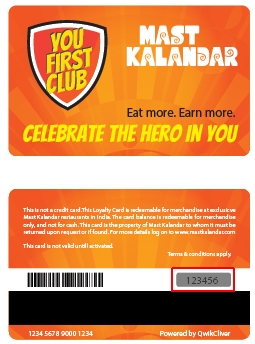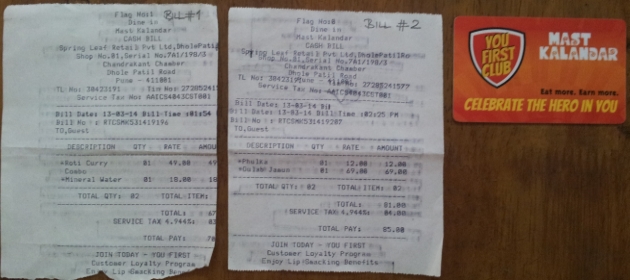
Mast Kalandar is a North Indian quick service restaurant chain that has branches in Bangalore, Pune and a few other Indian cities. I happened to visit one of its outlets recently. After placing my order at the cashier and making the payment, I received the receipt for my purchase. By chance, I noticed a mention of a loyalty program at the bottom of the receipt.
Since the last line or two of the receipt was torn, I couldn’t figure out what exactly I had to do to join the program and asked the cashier for clarification. She was clueless.
There was a lot of POP material inside the restaurant (e.g. posters about media coverage received by the company) but I couldn’t spot any info about the QSR’s loyalty program. The last two lines of the receipt seemed to carry the only mention of the program. So I asked for a duplicate receipt, hoping to figure out the next steps for enrollment by myself.
Some uniformed employee installing paper in the printer gruffly told me that they couldn’t issue a duplicate receipt. At best, they’d place a seal to authenticate the receipt. He didn’t realize this defeated the entire purpose for my requesting a duplicate receipt.
Mast Kalandar’s loyalty program started on this wrong note and steadily went downhill thereafter.
I told the cashier I wanted to sign up. She had no clue what to do. When I pushed her, she checked with somebody in the kitchen and gave me some sketchy details but still no one had any idea of how the program worked in terms of Earn Ratio (how much spend translated to how many reward points) or Burn Ratio (how many reward points translated to what value of gift).
I nevertheless decided to join. My delight at not being issued a long form to fill was shortlived: Enrollment required me to write down my personal details on a register kept at the payment counter. Since the register was wide open, everyone could see everyone else’s contact information, which I found a violation of privacy.

Anyway, having come thus far, I decided to go ahead and wrote out my name, mobile phone number, email address and date of birth on the register. The cashier asked me to return after a half hour to collect the plastic card.
When I did that, I noticed that there was a scratch panel on the back of the card. I scratched it out and found a six digit number. By that time, I’d received an SMS mentioning my 16-digit Loyalty Card number. So, I knew this 6-digit # couldn’t be my membership ID. The purpose of this number was not explained anywhere.
More importantly, I found that my account had zero reward points. Which meant that my that day’s spend hadn’t earned any rewards. I found this almost to be a breach of trust and, when I inquired with the staff, was told that only subsequent purchases would be eligible for points. This is a stupid discrepancy likely caused by a technical constraint in the software used by Mast Kalandar to run its loyalty program.
Thus ended my first visit to Mast Kalandar and my enrollment to its “You First” Privilege Club.
On my next visit, I’d forgotten to carry my loyalty card. This happens quite often and reiterates why mobile wallets should focus on loyalty, rather than payment, cards as I’d highlighted in Mobile Wallets Should Fix What’s Broken – And It Ain’t Payments. But I digress. When I mentioned to the cashier that I was a member of their loyalty program and asked him how I could accrue rewards for the purchase, he noted down my mobile phone number and promised to credit my account with the rewards due from the purchase. Many months later, I still haven’t received any confirmation that this has happened.
It’s over five months since I enrolled for Mast Kalandar’s loyalty program. During this period, I haven’t received a single message from the QSR enticing me back to its restaurant. And, you guessed right, I haven’t made any repeat purchase. If you’re thinking that’s not a great badge of honor for a loyalty program, you’re not alone.
At the risk of sounding overcritical, Mast Kalandar shows how not to run a loyalty program.
